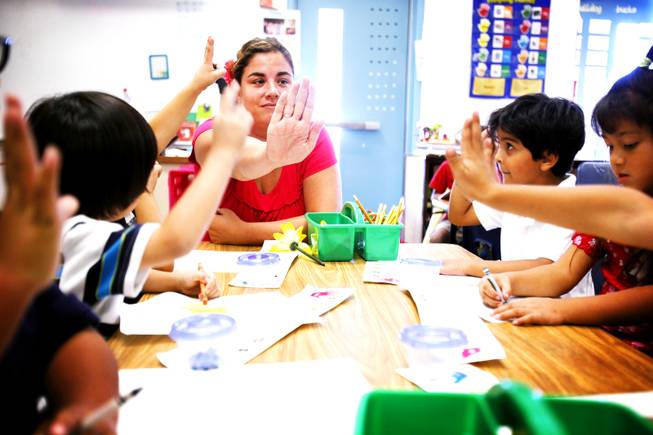
Teacher Paula Barry works with her kindergarten class at Elizondo Elementary School in North Las Vegas on Thursday, Sept. 29, 2011.
Published Thursday, Nov. 29, 2012 | 2:11 p.m.
Updated Thursday, Nov. 29, 2012 | 9:50 p.m.
Beyond the Sun
Sun coverage
The number of top-performing Clark County schools rose sharply last school year compared with the previous year, according to School District data released Thursday.
Under its school ranking system, the district's 328 traditional, magnet and charter schools are classified from one to five stars, based on academic performance and school climate data, such as student attendance.
There were 91 top-performing five-star schools in the district during the 2011-12 academic year, up from 51 in the 2010-11 school year.
That means a little more than a quarter of the district's ranked schools now have five-star status, up from 16 percent.
Notably, there are no one-star schools in the district. There were 12 one-star schools in the previous academic year.
The updated school rankings come just two days after a federal report found Nevada had the worst graduation rate among the states for the 2010-11 school year. The Silver State posted a 62 percent graduation rate, the lowest in the nation except for Washington, D.C., and Native American reservations.
"What you do will stop the dropout rate," School Board President Linda Young told a group of five-star school principals Thursday morning. "Together, we're moving from the fastest-growing to the fastest-improving (school district) in the nation."
•••
The School District launched its "School Performance Framework" ranking system in February, touting it as a transparent way for the public to hold the district and schools accountable for student performance. It's also a way for low-performing schools to learn best practices from the top-performing schools.
Under the ranking system — now in its second year of implementation — schools are scored on a 100-point scale and ranked on a five-star system. Similar school ranking systems exist in other major urban school districts, such as New York City, Los Angeles, Denver and Miami.
For elementary and middle schools, the majority of points are devoted to a school's academic performance: 44 points for test score improvements, 22 points for the percentage of proficient students and 22 points for closing the achievement gap between students of different backgrounds.
The remaining 12 points are devoted to a school's climate, which include average daily student attendance, performance of English Language Learner and special education students, survey results from students and teachers, and the number of students in accelerated classes.
High schools are rated similarly to lower grade levels, although proficiency rates, test scores and graduation rates are weighted more heavily.
Thirty-five points go to graduation rates, the percentage of students who are credit sufficient and the passing rate on the High School Proficiency Exam. Another 35 points go to college and career readiness, which includes adequate math and science course completion and participation in accelerated Advanced Placement courses. Twenty points go to test score improvements and 10 points go to school climate.
In all grade levels, schools are given five additional extra points for meeting self-imposed goals.
Schools are assigned star rankings based on their number of points. Five-star schools are given more autonomy over their budgets while one- and two-star schools are given more oversight and support, such as professional development.
•••
Overall, 77 percent of the district's ranked schools had acceptable three-, four- or five-star status, up from 69 percent in the previous year. This means the majority of Clark County Schools are showing adequate improvement in standardized test scores and other academic measures.
"We know we still have a lot of hard work to do, but we are making progress," Deputy Superintendent Pat Skorkowsky said.
This new ranking system was heralded for being a departure from the now-defunct federal No Child Left Behind school rating system, which was criticized for focusing more on the proficiency rates than improvement on standardized test scores.
Under the controversial NCLB system, only 39 percent of Clark County schools made the adequate yearly progress measure. Principals and teachers complained the system punished schools for failing to make proficiency despite making great strides in student achievement.
The new ranking's emphasis on student "growth" over proficiency helped elevate the status of Clark County Schools. However, if Clark County's incredible rate of improvement continues, 100 percent of schools will be considered adequately performing in the next three years.
Which begs the questions: How credible are these rankings if the majority of students are still not proficient? How effective is a ranking system that makes schools feel better about their improvement, but are still only graduating 62 to 65 percent of its students?
The School District is now wrestling with these questions, said consultant Ken Turner, the architect of the new rankings. In the future, the ranking system may focus more on proficiency and graduation rates, although the "growth" model is here to stay, he said.
"We believe growth is the right way to look at (student achievement)," Turner said. "We're still working on how much do we quantify growth?
•••
Some schools showed tremendous improvement despite long odds. Principals of five-star schools were treated Thursday morning to a go-cart ride at the Las Vegas Mini Grand Prix racetrack.
Among high schools, Western showed the most improvement, going from one-star to four-star status. Western is a turnaround high school, which underwent massive staff and leadership changes as well as an infusion of federal grant money.
For the first time this year, an urban comprehensive high school — Coronado — made the five-star status. Previously, only urban magnet schools and small rural comprehensive high schools made the list.
Among middle schools, Garrett and Lyon made the five-star status last year. No middle school made the five-star list during the 2010-11 school year.
Among elementary schools, Parson showed the most improvement, moving from one-star to five-star status in just one year. Similarly, Elizondo, Diskin, Hancock and Kelly elementary schools went from two-star to five-star status in one year.
Elizondo and Hancock are turnaround schools. Elizondo Principal Keith France credited his campus' "turnaround" efforts with its newfound status as a top-tier school.
The North Las Vegas elementary school faced daunting challenges: overcrowded classrooms and high poverty among students. However, with common teacher coaching and planning time, a new data-driven and rigorous school culture and increased parent involvement, Elizondo shot up in the rankings.
When the school found out its new five-star status, teachers cried, France said. They had worked so hard, but they weren't expecting to make the coveted five-star status, he said.
"We were so thrilled," he said. "It just confirmed all the things we were doing was working."
However, a school didn't need a radical approach to show tremendous growth. At Diskin Elementary school in the central-west valley, Principal Beth Smith was experiencing similar challenges of high poverty and a high population of English Language Learner students.
The aging school campus also had to contend with facilities issues. Earlier this year, Diskin temporarily closed because its air conditioning unit failed, moving its students to nearby Decker Elementary School.
Still, the seven-year principal persevered. Diskin invested in teacher development and after-school tutoring sessions to help students. The school also implemented "looping" whereby teachers travel with their students from grade level to grade level, which helps teachers develop long-term relationships with students.
The culture of high expectations and low teacher turnover helped vault the school to the top of the rankings, Smith said.
"I'm really proud of my students and staff," she said. "I don't believe in a lot of programs, but I believe in a lot of good teachers who work their hearts out and are committed to our school."
•••
School Board members at Thursday night's meeting commended the updated school rankings, but said it could be improved.
In particular, some board members took issue with the so-called "hold harmless" clause, which tries to maintain stability in the new ranking system.
Under this clause — which existed in the NCLB system — a school's highest rating stands for two years.
That means a one-star school that moves up to a five-star status is considered a five-star school. However, conversely, a five-star school that drops to a one-star status will still be considered a five-star school in the second year.
In fact, if the hold-harmless provision didn't exist, there were only 72 five-star schools in the district last year, not 91. There would also be six one-star schools, not zero.
That discrepancy irked School Board member Rene Cantu, who argued the "hold harmless" provision artificially inflated the number of top-performing schools. For example, the Agassi College Preparatory Academy — a northern valley charter school — is still rated a four-star school, even though it technically dropped to a two-star status.
School Board member Carolyn Edwards concurred. Although she saw some merits to the "hold harmless" clause, she was wary school leaders could avoid important discussions among staff and families about their school's academic progress by hiding under their higher ranking.
"There should be a dialogue, not just with teachers, but with parents," Edwards said. "There has to be a conversation with the community about why (a school) slipped."
Turner said the School District wasn't trying to mislead the public with the "hold harmless" provision, rather that it was a way to ensure the validity of the system, the kinks of which is still being ironed out.
Like a carpenter measures twice but cuts once, the school ranking system didn't want to immediately penalize a school for an off-year, he said.
"There was a lot of discussion over this," Turner said. "We wanted to give schools the benefit of the doubt."
Young and School Board Vice President Deanna Wright also argued the school ranking system fell short in capturing the quality of a school's non-academic learning pursuits, such as music, arts and sports.
By focusing largely on standardized test scores in core subject areas such as math, reading and science, the ranking system could be disregarding a school's other strengths in the arts and sports, Wright said.
"Those are the things that really matter to kids and family, especially when it comes to re-zoning (school attendance zones), Wright said. "We need to consider how we are going to measure theater and band. "They are so important to a student's development and school climate."
Turner said the School District may try to include extracurricular opportunities into a school's rating.
A ranking system for the district's remaining 27 behavior and non-traditional schools is still being developed, he added. A state-level school ranking system is also being generated.
Nevada's School Performance Framework is expected to be released in February. The School Board will have to decide whether to run the district's school ranking system concurrently with the state's system, or to abolish it.



Join the Discussion:
Check this out for a full explanation of our conversion to the LiveFyre commenting system and instructions on how to sign up for an account.
Full comments policy